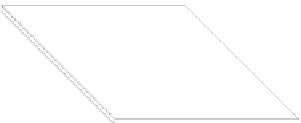Information Technology Reference
In-Depth Information
MAGNETS
C)
B)
ELECTRODES
PADS
A)
E)
D)
PZT SUBSTRATE
Fig. 17.
(A) Structure of the proposed circuit demonstrator. Two interdigitated elec-
trodes are fabricated on a PZT layer. Magnets are located in the area between two
electrodes arms. Contact pads are used to apply the voltage to the structure. (B) Fab-
rication Process. Fabrication of the PZT through sol-gel techniques. (C) Electrodes
fabrication through direct laser writing lithography. (D) Deposition of magnetic mate-
rial through sputtering and patterning of magnets through EBL or FIB lithography.
(E) Optional removal of magnetic material from the electrodes structure.
pattern the magnetic material to obtain magnets and to remove the magnetic
material in excess to avoid unwanted contacts between electrodes. The magnetic
material is normally a conductor so, also if it covers the electrodes, there will
be an electric contact. However, magnetic materials are normally bad electrical
conductors, so to improve the structure an optional step (Fig.
17
(E)) can be used
in order to remove the magnetic materials directly above the electrodes. Clearly
the area where magnets are located must be properly masked in the process.
Due to technical limitations we have not obtained the complete structure
yet, however in Fig.
18
we can illustrate some preliminary results. Figure
18
(A)
shows a scanning electron microscope (SEM) image of the electrodes structure.
It is possible to observe the contact pads and the electrodes. Arms of the two
electrodes are alternatively interleaved, in this way there will be a strain between
each couple of arms. The maximum resolution that we can currently obtain
with our lithography process is 2
m, so, as it is possible to note from Fig
18
(B),
electrodes sizes are in the micrometer range. These sizes are much bigger than the
desired ones, however, they are enough if the purpose is the demonstration of the
effective magnets reset and switching. Figure
18
(C) shows instead a SEM image
of a typical PZT substrate [
33
]. It is possible to observe its typical grain structure,
with grain sizes in the range of a hundred nanometers. The average roughness is
around 3 nm. Figure
18
(D) shows instead a film of Iron-Terbium. Iron-Terbium
is a material similar to Terfenol with high magnetostriction that we are studying
since our studies in [
107
]. Its surface is pretty rough for the moment and the
thickness is quite high: 500 nm. Our efforts are now concentrated on the creation
of thinner films with a lower roughness and its deposition on the PZT layer.
In the meantime we are using Nickel as magnetic material for our experiments.
Normally, an interface layer is used between the PZT and the magnets [
34
]. This
approach reduces the mechanical coupling so we are trying to avoid this choice,
depositing the magnetic layer directly on top of the PZT.
µ













































































































































Search WWH ::

Custom Search